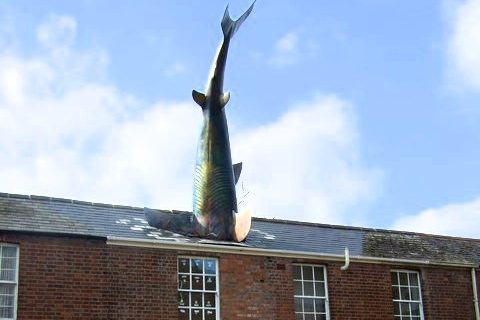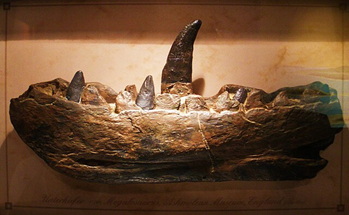Why did Heine choose to have a shark sticking out of his house?
There aren’t many who can claim to have a giant fibreglass shark on their own roof. Or own a cinema with a pair of legs hanging outside of it. This is the truth however for Mr William Randolph Heine, known as Bill Heine, radio presenter and local celebrity who gained worldwide attention after coming up with the idea to have a glass shark appearing to fall from the sky onto his property.
Bill Heine born in a farming-heavy area of Illinois on 9th January 1945. He studied American Diplomatic History at Georgetown University Washington DC alongside fellow classmate Bill Clinton, future president of the United States. While there, he worked in the White House and the Senate. He decided to study a postgraduate in Law and Jurisprudence at Balliol College in the 1960s. However, before his studies could be finished, he was sent home amidst the beginning of the Vietnam War. Heine however, managed to avoid military service by working as a volunteer in the Peace Corps, an American independent agency that provides economic and social support to other countries. Heine worked in Cusco, Peru for almost 3 years to assist on land reforming projects when the current Velasco Alvarado government was transferring litifundios (meaning privately owned land) to Quechua speaking operatives. Afterwards, Bill Heine was able to return to Oxford and graduated.
Later, in 1974 Heine brought a redundant cinema and called it the Penultimate Picture Palace in reference to his bank manager stating that this would be the second worst investment he could make. The cinema is located on Jeune Street, off the Cowley Road. After a 2 year renovation, which included mounting a giant pair of 3D hands onto the building by sculptor John Buckley (who later installed the famous shark) made the property a tourist attraction alongside its notoriously late-night programming and attitude against forms of censorship. One of the first films to be shown here was a British indie film Winstanley, a story of 17th-century social reformer George Winstanley and the idea of a self-governing community experimenting in socialism or communism at the time. In 1994 however, the building was closed due to managerial disagreements and small audience sizes. After another renovation, the cinema remains open as the Ultimate Picture Palace – one of Oxford’s only remaining independent cinemas.
Heine took over his second cinema Not The Moulin Rouge located on New High Street, Headington in 1980. Not The Moulin Rouge was renamed due to planning issues with having a windmill installed into the roof by the previous owner; Heine himself installed a pair of legs onto the front of the cinema. This started another battle with planners that Heine won and the legs were able to stay. Similarly to the Penultimate Picture House, Not The Moulin Rouge was famous both for its unique design outside and the anti-censorship stance on films. They often ran late into the night and would show all genres as an arthouse cinema. The cinema opened its doors with a showing of Roman Polanski’s Tess (1979) a controversial film about the nature of love. The cinema then closed its doors after a showing of Jean Renoir’s La Regle du Jeu (Rules of the Game) released in 1939, a French satirical film. Unfortunately the building was demolished later in 1991 for similar reasons and was replaced with housing. The legs themselves were moved to a cinema in Brighton, where they still are today.
In 1986 Bill Heine teamed up again with old friend John Buckley to create a 25 foot long fibreglass shark onto the roof of Heine’s Headington home, appearing to fall and crash into the roof. The shark was inspired by the planes which were spotted taking off from Hayford airfield to Libya during the political unrest. Heine also notes that the shark was created to represent his own feelings about nuclear bombings, particular events in Nagasaki and the disaster in Chernobyl. The shark is intended to signify someone “ripping a hole out of their roof out of impotence and anger and desperation”. The feeling of hopelessness when everything around you becomes changed by war, and a protest against the violence and barbarity that war brings. Heine also adds that this feeling of hopelessness came to him when swimming through shark infested waters when on a holiday after becoming injured, and the danger that it brought. The designs themselves were created by Buckley and were constructed with the help of anti-war activists and friend Anron Castiau and placed onto the roof of the house on the 41st anniversary of the dropping of the atomic bomb on Nagasaki, marked on the gate reading ‘Untitled 1986’, the name of the sculpture.
Despite this, the Headington Shark as it was now known locally, became the centre of a legal dispute. The Oxfordshire County Council attempted to remove the shark on the grounds that it may be unsafe for the public and occupants of the house. However upon inspection, the specialist roof supports installed to hold the shark were deemed safe and it was able to stay. In 1990 Bill Heine submitted a planning application for the retention of the shark titled ‘Untitled 1985’ but was refused. However Bill appealed to the Secretary of Environment who in 1992, allowed the appeal and the Headington Shark was able to stay permanently. On 26th August 2016 Bill’s son Magnus Hanson-Heine brought the famous Shark House which can now be rented as a Bed and Breakfast to save “a much-loved piece of art that might be destroyed”.
Heine began radio presenting in 1988 after proving to be a good interviewee when asked questions about his famous shark statue. He was invited to host a morning talk show every Sunday at 11am, simply titled Bill Heine. The show mainly consists of Heine speaking about topics and giving his own opinion on them, such as the bombings of Syria and their effect on national relations and security (Bombing Syria Debate, Bill Heine aired 6th December 2015). Additionally local issues surrounding Oxfordshire, such as flooding had been a centerpiece for discussion. There had also been several high profile guests, such as David Cameron (With PM David Cameron, aired 15th June 2014) and Alan Titchmarsh (The Broadband Debate and Alan Titchmarsh, aired 30th March 2014). Both Heine’s interviews and debates were filled to the brim with important questions and discussion. Heine was not afraid to be opinionated as a radio presenter and often would press others on his show, becoming a controversial figure who was not afraid to speak his mind. Bill Heine retired from radio presenting however, with his last broadcast of his own show on Sunday 24th April 2016, in a special show titled Bill’s interview archive, which looked back at his most iconic interviews with celebrity guests, celebrating 30 years in politics and entertainment.
Additionally, Heine also had his own column in the Oxford Mail, called Heine on Friday. This, similarly to the radio show, was centred around Oxford and its residents. Bill wrote for many years, with his final column being posted on 29th March 2019, shortly before his death due to acute myeloid leukemia aged 74. Bill Heine is a still beloved figure, renowned for his quick thinking and ability to do things outside the box. His fibreglass shark and storied career in radio presenting and writing compounded his deep affection for Oxfordshire and the UK as a whole. His messages against war and conflict alongside his eccentric and anti-bureaucratic notions make him a legend, and someone the people of Oxford can be proud to say lived in this city.
Written by volunteer Kylie Hunt.
Want to write your own Oxford-inspired post? Sign up as a volunteer blogger.



